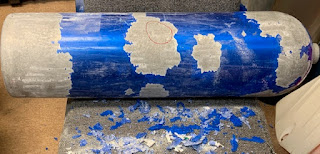Give Your Cylinders a New Look

Poor post-dive rinsing took its toll on this ocean diver's 80 but it's just cosmetic. Fred Stratton Instructor and Technician fred@bubblesornot.com Painting Scuba Cylinders Some divers give little thought to their cylinders. They only care that they don't leak and pass annual inspections and hydrostatic retesting once every five years. Other divers are meticulous about every piece of gear, including their cylinders. They put boots, dust caps and nets on them to keep that showroom paint job intact. If you regularly dive it's inevitable that your bottles will get chipped and scratched and as water works its magic, the paint will flake off. So what can you do when it happens? " Can I strip the paint off my cylinders without damaging the metal?" The stripper works quickly. Scrape the peeled paint before it dries. American cylinder manufacturers Catalina and Luxfer recommend using Zip Strip to rid your cylinder of what remains of the facto...





